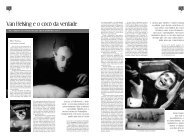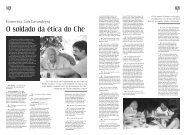Merleau-Ponty, 1964. Eye and mind. - Biolinguagem
Merleau-Ponty, 1964. Eye and mind. - Biolinguagem
Merleau-Ponty, 1964. Eye and mind. - Biolinguagem
- No tags were found...
Create successful ePaper yourself
Turn your PDF publications into a flip-book with our unique Google optimized e-Paper software.
that a painter comes into full possession of his vision. But that is not the question;<br />
precocious or belated, spontaneous or cultivated in museums, his vision in any event<br />
learns only by seeing <strong>and</strong> learns only from itself. The eye sees the world, <strong>and</strong> what it<br />
would need to be a painting, sees what keeps a painting from being itself, sees—on the<br />
palette—the colors awaited by the painting, <strong>and</strong> sees, once it is done, the painting that<br />
answers to all these inadequacies just as it sees the paintings of others as other answers<br />
to other inadequacies.<br />
It is no more possible to make a restrictive inventory of the visible than it is to catalog the<br />
possible expressions of a language or even its vocabulary <strong>and</strong> turns of phrase. The eye<br />
is an instrument that moves itself, a means which invents its own ends; it is that which<br />
has been moved by some impact of the world, which it then restores to the visible<br />
through the traces of a h<strong>and</strong>.<br />
In whatever civilization it is born, from whatever beliefs, motives, or thoughts, no matter<br />
what ceremonies surround it—<strong>and</strong> even when it appears devoted to something else—<br />
from Lascaux to our time, pure or impure, figurative or not, painting celebrates no other<br />
enigma but that of visibility.<br />
What we have just said amounts to a truism. The painter's world is a visible world,<br />
nothing but visible: a world almost mad, because it is complete though only partial.<br />
Painting awakens <strong>and</strong> carries to its highest pitch a delirium which is vision itself, for to<br />
see is to have at a distance; painting extends this strange possession to all aspects of<br />
Being, which must somehow become visible in order to enter into the work of art. When,<br />
apropos of Italian painting, the young Berenson spoke of an evocation of tactile values,<br />
he could hardly have been more mistaken; painting evokes nothing, least of all the tactile.<br />
What it does is entirely different, almost the inverse. It gives visible existence to what<br />
profane vision believes to be invisible; thanks to it we do not need a "muscular sense" in<br />
order to possess the voluminosity of the world. This voracious vision, reaching beyond<br />
the "visual givens," opens upon a texture of Being of which the discrete sensorial<br />
messages are only the punctuations or the caesurae. The eye lives in this texture as a<br />
man in his house.<br />
Let us remain within the visible in the narrow <strong>and</strong> prosaic sense. The painter, any painter,<br />
while he is painting, practices a magical theory of vision. He is obliged to admit that<br />
objects before him pass into him or else that, according to Malebranche's sarcastic<br />
dilemma, the <strong>mind</strong> goes out through the eyes to w<strong>and</strong>er among objects; for he never<br />
ceases adjusting his clairvoyance to them. (It makes no difference if he does not paint<br />
from "nature"; he paints, in any case, because he has seen, because the world has at<br />
least once emblazoned in him the ciphers of the visible.) He must affirm, as one<br />
philosopher has said, that vision is a mirror or concentration of the universe or thai, in<br />
another's words, the idios kosmos opens by virtue of vision upon a koinos kosmos; in<br />
short, that the same thing is both out there in the world <strong>and</strong> here at the heart of vision—<br />
the same or, if you will, a similar thing, but according to an efficient similarity which is the<br />
parent, the genesis, the metamorphosis of being into its vision. It is the mountain itself<br />
which from out there makes itself seen by the painter; it is the mountain that he<br />
interrogates with his gaze.<br />
What exactly does he ask of it To unveil the means, visible <strong>and</strong> not otherwise, by which<br />
it makes itself mountain before our eyes. Light, lighting, shadows, reflections, color, all<br />
these objects of his quest are not altogether real objects; like ghosts, they have only<br />
visual existence. In fact they exist only at the threshold of profane vision; they are not<br />
ordinarily seen. The painter's gaze asks them what they do to suddenly cause something<br />
to be <strong>and</strong> to be this thing, what they do to compose this talisman of a world, to make us<br />
5









